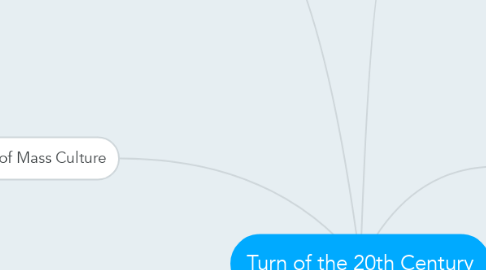Turn of the 20th Century
by Paige Ringhofer

1. Technology
1.1. Street car invented to transport workers to urban areas from suburbs.
1.2. The first airmail system was started in the 1920's after the Wright brothers mastered their first flight which allowed for planes to be flown cross country and mail was able to be moved much faster than in previous years.
1.3. Paper mills were built and expanded to print newspaper, magazines, books and more as most Americans were becoming literate.
2. Segregation and Discrimination
2.1. With people other than white.
2.2. Discrimination found in the workplace, in the school systems, public buildings like libraries and even in public accommodations like bathrooms and water fountains.
2.3. Led to poverty cycle in many of these groups because people were not able to find better work with lack of education.
2.4. Many employers did not want people of other races, no matter their qualifications.
3. Dawn of Mass Culture
3.1. Rise of leisure activities for people on the work weekends.
3.2. Bicycling and tennis were popular activites for both men and women, riding a bike was a big step for women and their equality fight with men.
3.3. Amusement parks and theaters opened up for people who wanted to relieve stress from the work week and get out of the city for awhile.
3.4. Shopping increase with catalogs no one had to go to the store but large department stores had lots of different items and were booming with business.
4. City Life
4.1. City life became geared towards business, industry and entertainment. Most people lived outside of the city in suburbs so business was largely done in cities and home life was in the suburbs.
4.2. Skyscrapers were built by the hundreds of thousands in order to have more businesses in urban areas and maximize spaces.
4.3. Urban Planning was a huge deal in city life. Roads, bridges and tracks were carefully planned out in order to develop areas of cities to place skyscrapers, buildings, theaters, parks and more to draw people to cities for work and entertainment in a functional manner.
5. Expanding Public Education
5.1. Immigrant children were now able to be educated in order for them to learn to speak English and master basic skills to get a better paying job.
5.2. Children were now going to school instead of working in dangerous factories all day which allowed the American economy to shift from only factory work to more business and innovative work.
5.3. Children were now learning basic skills like reading , writing, arithmetic, social studies and science. With reading and writing now taught, most Americans were literate and the push for more paper mills were increased.
6. Expanding Higher Education
6.1. Universities began popping up which allowed people to specialize in industries.
6.2. Despite discrimination, people of color were admitted to colleges specifically for colored people so that they were able to get a higher education for better jobs, just the like white people were.
6.3. Usually it was white men that went off to higher education, but white women also went on to higher education. At first there were not many women pursuing this track but after the world wars, many more women find themselves able to work outside of the home and pursue higher education.


